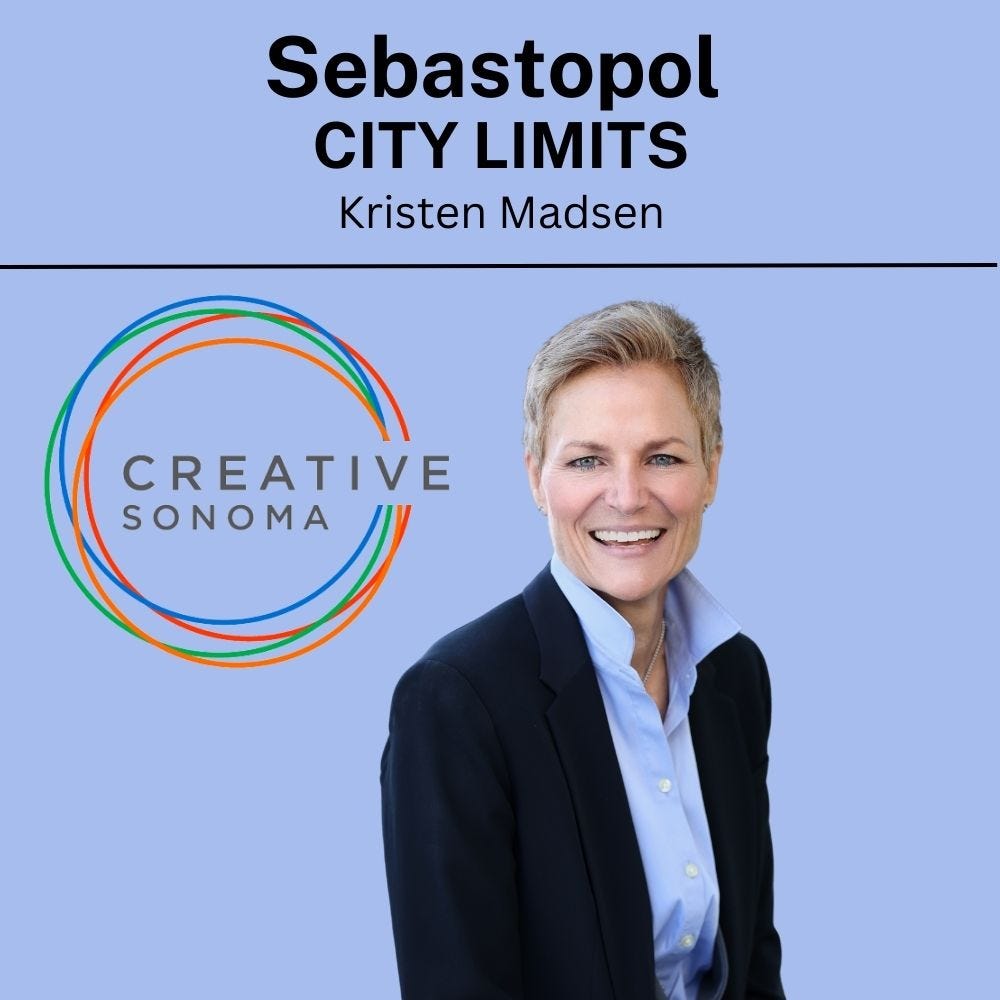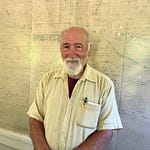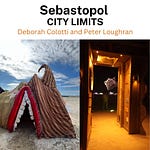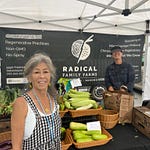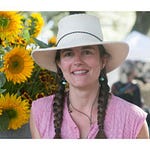My conversation with Kristen Madsen, director of Creative Sonoma, explores how arts organizations are adapting to life after the never-say-goodbye pandemic as well as the ongoing assessment of the role of the arts and arts education in our community. It continues a discussion about challenges facing the Sebastopol Center for the Arts, which we featured in a previous article. The challenges facing our local arts institution are similar to those faced by organizations throughout the county and nation due in part to Covid but also because our relationship to art itself keeps changing.
Highlights
“We live in what's known as the Economic Development Department, and we like that because it means that somebody who put Creative Sonoma together recognized that we are the creative sector and it contributes to the economy.”
“I do think that the promise of technology turned into kind of a clashing realization that, oh, wait a minute. Now, there aren't the same kind of systems that you used to follow, particularly as an individual, to have a career in the arts that you used to.”
“Community art centers have so many roles to fill, and it's part of their strength and part of their challenge. Because they have to be many things to many people.”
“The one thing that I do think had a little bit of promise fulfilled is it does allow for what I'll call a middle class life as an artist in a way that didn't exactly exist before. You were either just struggling up and coming and stayed struggling forever. Or you were the far end of the hyper successful artist. But now you can have art making as part of your life and maybe other things too.”
“I think our community and all communities are redefining who we are in the post Covid, but also post George Floyd era and thinking about the definitions of who community is and how who wrote those definitions. That gives a community arts center really tremendous new horizons to play in.”
“In that timeframe (over the last year), as we talked to people, everybody was okay because of all of the state and federal supports that were coming to them. So we didn't see permanent closures at that point in time.”
“If you divide arts organizations into three categories: one is small, so say their annual budget is under a hundred thousand dollars, and then middle-size, it would be a hundred to maybe a million, and then above a million. So small, medium, and large. The smalls and the large survive a crisis with less trouble. It doesn't mean not a lot of trouble, but they survive.”
“Creative Sonoma started a new program last year and we're in now our second year. We have fellowships for individuals that are working in and or for communities of color.”
Transcript
Dale: Welcome to Kristen Madsen. And Kristen is the director of Creative Sonoma. Kristen. Welcome.
Kristen: Thank you. Nice to talk to you too. Dale.
Dale: Give us some background on yourself. Who are you and are you an arts person yourself?
Kristen: I am now an eight year resident of Sonoma County. I came up here from Los Angeles where I was working for 20 years at the organization that produces the Grammy Awards, working on the music side of things, and also in the two non-profits that the Grammy established to help music people in crisis and also, to forward the issue of arts education, music education particularly. I started with the love of music because I started playing the piano when I was five years old, mainly because I idolized my older sisters who were having lessons already and I had to be like them.
Dale: That's what happens sometimes.
Kristen: Exactly. As it turns out, it stuck with me and not with them. But so music and art has been my career -- my life and my career, which has been great. Spot forward to wanting to not spend the rest of my life in Los Angeles and thinking about where might be a place that we discovered was more nourishing than punishing. And that's Sonoma County. And so we picked this place and then found out how we could get here.
I got lucky enough to get hired to be the first director of Creative Sonoma eight years ago. It is a county agency. We live in what's known as the Economic Development Department, and we like that because it means that somebody who put Creative Sonoma together recognized that we are the creative sector and it contributes to the economy.
So often arts and creativity get pushed to the side as sort of an add-on after the fact and seen a little bit more as an economic drain. But we know and consider ourselves fortunate to be recognized as a driver of the economy. So that's me and that's how I got here.
Dale: The word "creatives" has become popular almost not really meaning artists as much as just almost sort of new kinds of work.
Kristen: Yes, it is. What it reminds me because the word curate has also undergone that same kind of adoption from other folks and forces. And I mostly, I feel completely fine with that, especially when it's arts words, because I feel like when the broader world looks at what the arts are doing and says, oh, I love that's, try that on and see if it fits me. That in general is a positive for conversation about art and creativity.
Dale: We do a lot of separating. You're creative, you go in that corner and you're science or something, and you go in that corner.
Kristen: Exactly.
Dale: Especially these days, the world of work needs both kind of their literacies or competencies.
But traditionally, the people that are artists in our community are also trying to make a living at that. And that's become harder and harder, hasn't it?
Kristen: Definitely has. It's a myth that I guess nobody believes anymore, which was that technology was really going to make it easier for artists and musicians. By the way, I'll use the word artist and art meaning, ecumenically all genres, all art forms, not just visual art. But I do think that the promise of technology turned into kind of a clashing realization that, oh, wait a minute. Now, there aren't the same kind of systems that you used to follow, particularly as an individual, to have a career in the arts that you used to. On one hand, that should mean, oh, good, open door. I don't have to go through these systems. But at the same time, all the supports that existed in those systems are now born on the shoulders of the individual artists themselves.
So now you have to do all of that for yourself. And since there's very different or fewer filters between you and the general public, that also means that everything is available for everybody all the time, everywhere. It's overwhelming.
I find myself, and I think artists too, you still have to find a trusted and respected filter of some sort. And for some people that's the New York Times, or an art critic somewhere, or a gallery owner or a musician, a playlist by someone that they like.
Dale: It can also mean your local community where you live-- you're connected to other people who make art.
Kristen: That's a really good point. The one thing that I do think had a little bit of promise fulfilled is it does allow for what I'll call a middle class life as an artist in a way that didn't exactly exist before. You were either just struggling up and coming and stayed struggling forever. Or you were the far end of the hyper successful artist.
But now you can have art making as part of your life and maybe other things too. And do just regional schooling if you're a musician, for example, or regional sales. So you get beyond your immediate backyard. A little bit, but you don't have to be considered, national or international to be able to make enough money to make it worth it. So that again, that was a big generalization.
There's lots of gaping challenges within what I said, but I do think that's possible.
Dale: There's a traditional role, places like art centers in communities, which help to connect the public to art and to the artists. We're going to talk about the Sebastopol Arts Center as one of those. There's Mendocino, there's Petaluma. Most communities have something like that. That is that sort of curation role that you were talking about. But it's also just making sure art doesn't leave our consciousness on a daily basis.
Kristen: I think that's right. Community art centers have so many roles to fill, and it's part of their strength and part of their challenge. Because they have to be many things to many people. They're not solely a concert series. They're not solely a gallery. They really are a gathering place to the comment that you were just saying.
They do have a mission of how do we help the community recognize what we have here and who we are and help us define who we are based on what we see and do around art. They often have education classes for not just K-12, but adults, to perpetuate art making. That's a really big, important part of lots of our community art centers as well.
And then, yes, exposure to art and what it means in our lives and what we want it to mean in our lives. And that's, again, it's the source of talent, but it's also the source of opportunity. In some ways because I think our community and all communities are redefining who we are in the post Covid, but also post George Floyd era and thinking about the definitions of who community is and how who wrote those definitions. That gives a community arts center really tremendous new horizons to play in.
Dale: I guess what I wanted to get an understanding from you, cause you're probably tapped into this happening through lots of different organizations, what are the struggles and some of the solutions that people are grappling with?
Kristen: It's a really important question and everyone's asking it and answering it in different ways. I think really the true answer is we're not really even yet sure. So a couple of general thoughts about it. One, we did a study. We fortunately had done a study as a nonprofit arts organization in Sonoma County in 2019, and so we had a baseline of who was out there and what were they doing, what's their budget size, and a little bit of the health. Then we did a check-in about a year into Covid. We thought at the time, oh, this'll be like our post Covid report. We thought we were at the end-- to just see how people were coping. That's when we saw the strategies that so many of our groups, including Sebastopol Center for the Arts, were taking to say, first of all, if you had space, what that meant and so many folks looking at how they could use that space in different ways for different community purposes. Sebastopol Center for the Arts did some of the most interesting and positive work in school pods of kids that were coming from underserved backgrounds that didn't have childcare at home, that kind of thing. And did really wonderful learning generally, but with an arts angle to it. So that was great. You saw people also pick up their skillsets in digital transmission of what it was that they do. Not just Zoom, but all kinds of digital technology to try to help people have access to the arts in different ways.
In that timeframe, as we talked to people, everybody was okay because of all of the state and federal supports that were coming to them. So we didn't see permanent closures at that point in time. People were just hanging on and waiting and testing the waters and getting audiences that were coming from farther away than Sonoma County because they were doing it online.
So then as the reopening began, there was this flush of enthusiasm. People could get together again. Some of our performing arts groups and museums and other institutions started really seeing this pent-up demand. People felt much more strongly about how they were doing both with attendance and tickets than they had expected and even somewhat in fundraising. Sonoma County knows this only too well; donor fatigue around crisis funding and emergency funding; on the heels of the fires and floods that we've had here, who knew how we would come out after now a pandemic? So now I feel like we're in another phase, which is a little bit of a settling phase, right?
Now we're starting to see what I think are going to be closer to the real audience pattern. I think that's really the biggest challenge. To your comment, how do you support this work that you're doing? And for most of our groups, that means how do they get people to pay attention and open up their wallets?
There are some national trends on that which are showing that museums are doing okay, and museums that are attached to anything that's outdoors better because people are still hanging on to wanting to be out and/or be active. But sitting in an enclosed space is still really a challenge.
So performing arts, concerts, film, anything that brings you in a theater that you're just sitting down that just has not come back yet. And so now that's a couple years of that happening, and that might be not just a slow change. That might be a new normal, kind of a trend.
I'll marry that to something else, which is obviously there prior to Covid was the way people consume, to use a marketing term, but consume art has really changed in the last decade. There's so much more interest and willingness, especially for younger generations, I will say, to consume your art on a screen than live. So I think those two things are combining full performing arts or gathering place art in a negative way to what the old pattern were.
So to your question, What are people going to do?
Dale: It's an interesting parallel in ways is the Covid isolation and social media isolation, and encountering that with people need to be in person with other people to see things, experience things. It'll be interesting to see how that comes back.
Kristen: I think that's actually that's a really interesting point and deserves more exploration from people who are smarter than I am. But I'll also say I think that the the comment about needing to be together, I think everybody felt that and will still feel that, but I think we just interrupted our patterns so much.
I've not gone to a movie theater since pre Covid. And by the way, I was slowing down on going to movie theaters before Covid. So that's where I think that's going to be an issue. So what will make it a different experience, and by the way, I don't know, is having, spending $20 in order to have food delivered to my chair and a recliner is the answer.
One thing I do think that most of our arts groups can learn from and are trying to, is during Covid, they connected more one-to-one with their audiences. They had to and they had access, right? They had people on a Zoom call with their name right there.
Maybe they, they had to have their email in order for them to sign up for the Zoom link, those kinds of things. But they began to communicate in more of a dialogue. One-to-one or one-to-few versus solely a quick broadcast communication out to the world, and who knew if anyone got it or would respond back.
So there's something there that's of value.
Dale: Some of that could be regarded as innovations, the teaching an art class via Zoom. I know just from friends and things that we grumbled about it in the beginning, but we got used to it and liked it. It was convenient and, you could maybe do more of it. So I hope throw that out completely.
Kristen: I agree completely, and I'm sure you know this from also on the business side of things. You can do so many more meetings. We're a countywide agency. I can meet with people in a week's time via Zoom that I would never get to if I were going face to face to all those meetings.
At that the same time, every meeting I have via Zoom, I recognize what is not occurring, which is a different kind of personal connection that you have with people when you're sitting across the table from them .
Dale: Let me ask you just briefly, what do you think the government's role is in all of this?
Different countries in Europe tends to fund the arts more, tends to be part of its public mission. Less so in the United States and particularly in times when we have a lot of need for social services and other things. Art is usually set aside a bit.
Kristen: I don't think I'll surprise you when I tell you that I believe it's fundamental. I say believe it is 100% fundamental. There are things that will not occur if the government doesn't seed the ground with funding for it. I recognize more so I think after Covid than in any other time in my lifetime working in the arts that we force our artists and our arts organizations into feast and famine cycles. It's just cruel and unusual. We should not be doing that. When we need them, we want them right there. When a crisis occurs, what's the first thing that happens? People come together, they gather, they sing, they create roadside shrine, when there's been a tragedy. After 911, during Covid, the trumpeter is on the balconies.
We gather together, and music and art express the things that we, normal humans don't have the ability to say all the time in words or want to say in words. We rely on our artists to do that for us. Now, it's like anything else. If you only turn to your generator when you need it and you haven't maintained it, your generator's not going to work for you.
That's what we do to the art community all the time. And we also have done that through not putting enough attention to arts education. So we don't have kids who, maybe they're not all going to be an artist or a musician, but if they don't understand what art is, if they don't think in a creative way, if they don't appreciate it, they won't know what they're missing.
We have this after Prop 13 and the property tax reform, which decimated arts in the school system for generations. Now we have kids that have come up that have not learned an instrument. That's going to be too late. I don't mean doomsday, but that's going to be harder for them.
I'll shift my soapboxing a little bit here. There are a few places where I do think it's really critical for government, and one is arts education, so arts in the schools and making sure that every kid has access to it, and that plays out in a thousand ways.
Dale: That's really an equity issue because kids in private schools get that, right?
Kristen: 100%.
Dale: In public schools, it gets cut out and there was past some funding in the last election for more arts.
Kristen: There's a research that is a special gut punch I call it, around arts and equity, which is that kids from communities and families that are underserved kids, actually the impact for those kids -- if they have four years of arts intensive, immersive training is far and away farther than it is for kids that come from privilege. So the kids who need it the most and benefit the most from, get it the least.
So yes, it is 100% equity issue. So I think that's a critical place. I think art in our public realm, art in public places. We talk all the time about Sonoma being a really artistic community full of artists. That's true. But what do we say about ourselves in terms of what is the art that our municipalities and our government say belongs in our public domain?
And when when you go to a place where they've thought about this, and the zoning has taken good attention to it and the planners have paid attention to it and there's a percent for art ordinance-- you know it when you're there because you just look around and you see the evidence of it in the way the plazas are shaped and not just because there's a statue in the middle of a plaza.
Cause that's, yes, that is public art, but there's so much more. What's the landscape environment, what's the architectural structure. When you really care about it, it changes the nature of a community and your community and the what your government reflects what your priorities are. So I do think those are two places. There's plenty of others.
Dale: Maybe that's a good way of saying this. It's to some degree making art a priority is one of the challenges right now. And I think it's been nice to see with Sebastopol Center for the Arts that when you say we need help people come out and say "I didn't know you needed help. Let me step up and help." So I'm hoping making people aware of this, will cause them to not only recognize they value it, but they actually need to step up and support it.
Kristen: I think we see that a lot. There's one other thing that I think is a factor to share, because I do think it plays into the Sebastopol Center for the Arts situation and some of our other groups in Sonoma County.
Again, this is research pre Covid, but I think Covid essentially bore out the research, or maybe even that it exacerbated it. If you divide arts organizations into three categories: one is small, so say their annual budget is under a hundred thousand dollars. And then middle size, it would be a hundred to maybe a million, and then above a million. So small, medium, and large. The smalls and the large survive a crisis with less trouble. It doesn't mean not a lot of trouble, but they survive. The little guys survive cause they're used to doing everything, either all volunteer or with duct tape. That's how that they function. And the big guys, probably have access to some endowment funds and probably some institutional holdings and probably a different level of influence among board members who can give or help get. But if the folks that are in the center that have probably just enough assets, they might have a rent payment on a space or a mortgage. They may have some salaries for some staff. Maybe they have some assets that cost to store, et cetera. Those guys, that's really tough cause they're on the bubble of, paycheck to paycheck, donation to donation, for everything that they're doing. So in the pandemic, that's I think the group that we're going to see, the ones that ultimately do shut their doors, are the ones that had just kinda gotten over that threshold. They weren't all volunteer anymore, they were established, they were doing things, but not at a super successful level.
Dale: Also with having to lay people off during Covid, it's hard to get restarted, to get the right people back, to make those activities successful again. Fundraising is really quite a challenge, isn't it?
Kristen: No question.
Dale: Yeah. Good. Just what positive things do you see coming up? Events or things that are happening in the county?
Kristen: Whenever I say something, I start talking about particular organizations. I have to preface it by saying there's so many. And by the way Creative Sonoma loves all God's creative children in Sonoma County.
Equally, we love you all
Dale: As best you can. Yeah.
Kristen: I'm really encouraged by, even though I just said it was, it's going to be hard performing. Do some really spectacular live music. The roster for the Healdsburg Jazz Festival is off the charts. They have the Grammy's best new artist who's just a spectacular jazz artist and a couple of other names that just dropped last week, which is great.
Yo Yo Ma was just at the Green Music Center. The quality of really high level musicians is really great. Plus Luther Burbank Center doing Luther Locals, they're moving it outside. So that's every, I think it's one day of the week and it's local bands that are getting visibility. They started it during Covid and they were all on Zoom and now they're going to be live outside. So what a fun way to see some, really great musicians that are local and support our local team here. Because they really struggled, our local musicians definitely struggled during the pandemic.
Love what's coming down the road at Museum of Sonoma County and actually out in the Sonoma Valley Museum. Then I'll tell you that we're having fun getting to know some new community members. I'm going to brag a little on Creative Sonoma, but we started a new program last year and we're in now our second year of fellowship for individuals that are working in and or for communities of color. The idea is that they'll get a grant to do new work, but there'll also be a cohort that will learn together and will give them training to try to help them understand the pathways to funding or understand how to market or understand things that they tell us they want to know in order to be better at what they do. Our goal is that we develop over time a new cadre of new arts leaders that are speaking with voices that have not been heard and haven't been seen, as easily, shall we say, for some of us. So if we can put a spotlight on that, I think that will be really great.
Dale: Okay, Kristen, thank you for your time today and I appreciate learning about Creative Sonoma and your perspective on the art scene in Sonoma County.
Kristen: You're welcome. It was such a pleasure. Thank you very much. Dale.



